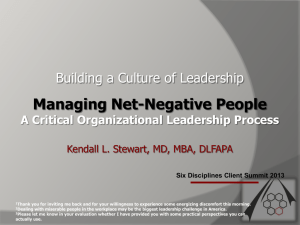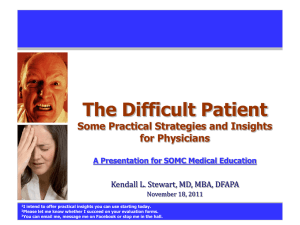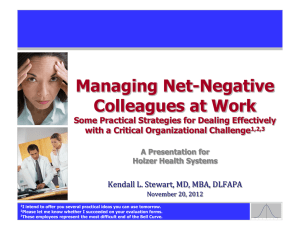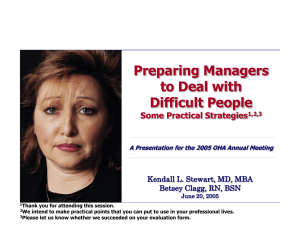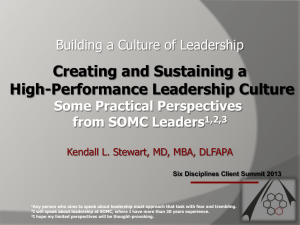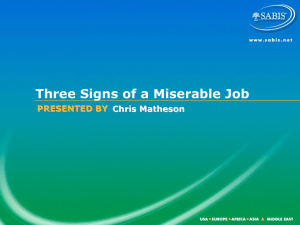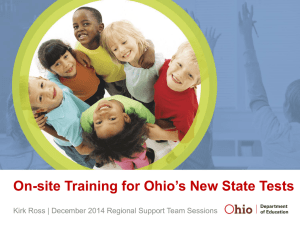On Being Positive in a Negative Environment
advertisement
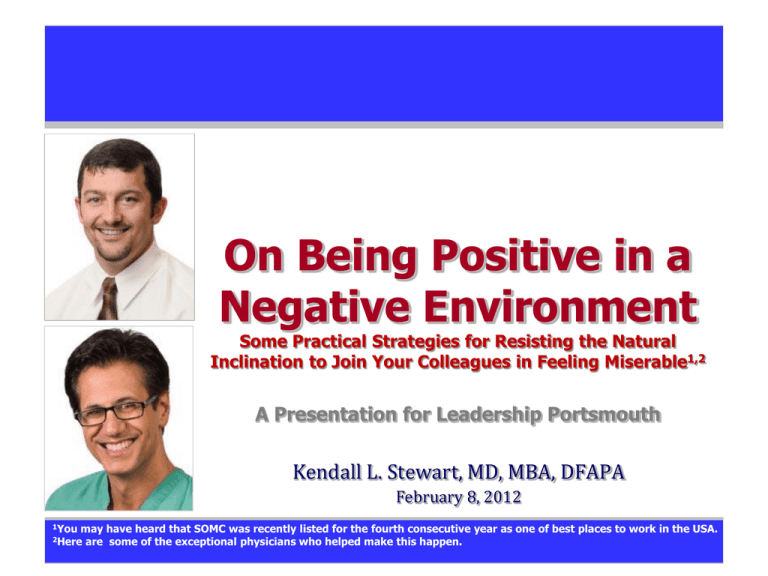
On Being Positive in a Negative Environment Some Practical Strategies for Resisting the Natural Inclination to Join Your Colleagues in Feeling Miserable1,2 A Presentation for Leadership Portsmouth Kendall L. Stewart, MD, MBA, DFAPA February 8, 2012 1You may have heard that SOMC was recently listed for the fourth consecutive year as one of best places to work in the USA. are some of the exceptional physicians who helped make this happen. 2Here What’s in this for you? • • • • • • • • Unfortunately, difficult work environments are pretty common. Even in the best environments, negative forces are constantly seeking to undermine and destroy. The people working in those environments are at risk for turning negative and becoming miserable. But life is too short to be miserable. There are effective ways to be positive in the most negative environments—if you put your mind to it. This practical presentation will detail some of those proven strategies. The rest is up to you. Organizational excellence and the maintenance of a positive culture do not occur without the sustained investment of emotional energy. 1Difficult 2A people are everywhere. difficult farmer was unhappy with his wife. • • • After mastering the information in this presentation, you will be able to – Describe three characteristics of negative organizational environments, – Detail three strategies for remaining positive in a negative environment, – Explain why you should adopt those strategies, and – Specify how you can successfully execute them. Work environments take on the personalities of the people who create them. As a leader, you can make a difference.1,2 What are some characteristics of negative work environments? • There are real problems that need to be fixed. • The whiners set the tone. • Cynicism rules. • Do-gooders are ridiculed. • Thin skin is epidemic. • Resentment abounds. • Criticism is the favorite pastime. • People are hesitant to take risks. • Secrecy is common; transparency is rare. • Conflict is avoided. • People are convinced that nothing will ever change. 1Let 2I • People talk about each other instead of to each other. • Expectations are not clear. • Emotional arousal is viewed as normal and inevitable.1,2 • People don’t cut each other much slack. • People don’t have much fun at work. • Bad actors are not confronted, and unpleasant consequences are not attached to misbehavior. • The worst possible motives are assumed. me tell you about medical school and residency. thought my career was about to end in my third year of medical school. What strategies will allow you to create a positive workplace? • • • • • • • • • • 1I 2I Focus on being positive. Focus on networking with other positive people. Focus on changing yourself, not others.1,2 Focus on facing up to the problems. Focus on customer service. Focus on quality. Focus on hiring positive people. Focus on confronting and extruding “net-negative” people. Focus on overcoming your own prejudices. Focus on fielding the best possible leadership team. • • • • • • • • • • Focus on annual strategic celebration and planning. Focus on brainstorming. Focus on setting priorities. Focus on measuring things that matter. Focus on staying busy. Focus on the long haul. Focus on accepting others’ negative feelings without sharing them. Focus on clarifying and enforcing “Rules of Engagement.” Focus on quarantining negative contagion. Focus on documenting incremental success. remember making up my mind to be positive when assisting in thoracic surgery. wasn’t the only one who didn’t know my anatomy. Extrude the net-negative people. • Why should you? – Everyone has positives and negatives. – Sometimes, a person’s negatives outweigh his or her positives—in the current environment. – Retaining such people limits the progress of the entire group. – This is particularly true if the netnegative person is a leader. – Retaining these people persuades others that negative behavior is acceptable. – Borderline folk conclude that it is okay to behave that way too. – This situation discourages the positive people. – But, admittedly, confrontation is hard. 1I • How can you? – Begin by observing and documenting positive and negative interpersonal behavior in the workplace. – Focus on patterns, not isolated incidents. – For each negative pattern you document, write down the positive “antidote” behavior. – Share your work with colleagues who will embrace it and contribute further. – Push for group acceptance. – Confront individuals who violate this code of conduct. – Use a facilitated 360-degree evaluation to confront the troublemakers.1 began reflecting deeply on this notion of net-positive and net-negative people in college. What have you learned? • Difficult, challenging work environments are common. • Those of us working in those environments are at risk for turning negative and becoming miserable. • But life is too short to be miserable. • There are some proven strategies for remaining positive in the most negative environments. • These strategies must be customized, but they will work. • Try them out. • You can make a difference in your life—and the lives of those around you.1 1I heard the voice of God in Kmart. Where can you learn more? • • • • • • • Join the discussion about practical approaches to more effective leadership on the SOMC Leadership Blog. Learn more about Southern Ohio Medical Center here. Review and download this presentation and related presentations and white papers here. Read Results That Last: Hardwiring Behaviors That Will Take Your Company to the Top to review some leadership strategies that successful health care executives have embraced. Learn more about how to confront others effectively by reading A Portable Mentor for Organizational Leaders. Review practical techniques for conducting crucial conversations in Crucial Conversations: Tools for Talking When Stakes are High. Consider adding the practical and comprehensive Successful Manager’s Handbook to your personal library. How can you contact me?1 Kendall L. Stewart, M.D. VPMA and Chief Medical Officer Southern Ohio Medical Center Chairman & CEO The SOMC Medical Care Foundation, Inc. 1805 27th Street Waller Building Suite B01 Portsmouth, Ohio 45662 740.356.8153 StewartK@somc.org KendallLStewartMD@yahoo.com www.somc.org www.KendallLStewartMD.com 1Speaking and consultation fees benefit the SOMC Endowment Fund. Are there other questions? Safety Quality Service Relationships Performance
